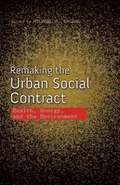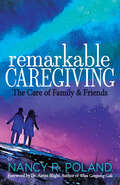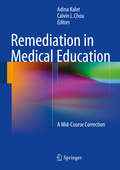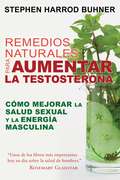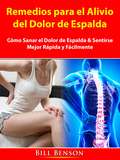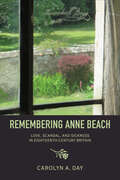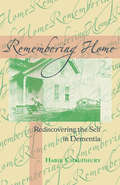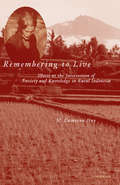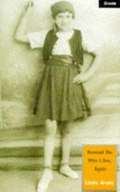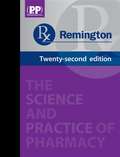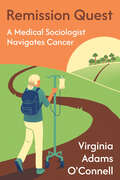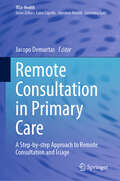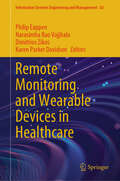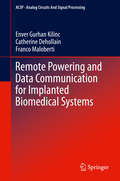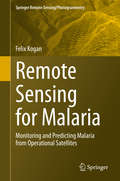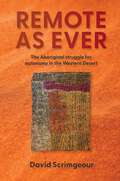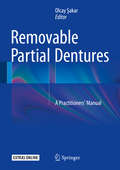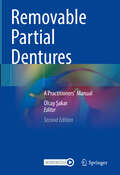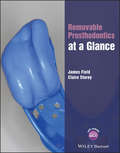- Table View
- List View
Remaking the Urban Social Contract: Health, Energy, and the Environment
by Michael A. PaganoThis new volume draws from provocative discussions on the urban social contract among policy makers, researchers, public intellectuals, and citizens at the 2015 UIC Urban Forum. Michael A. Pagano presents papers that emphasize political agreements, disagreements, challenges, and controversies on health, energy, and environmental policies. Authors explore the substantive and philosophical changes in the urban social contract and offer proposals for remaking it in the new century. Topics range from big-picture analyses to specifics covering areas like public services, the smart cities movement, and greening strategies. Contributors: Alba Alexander, Megan Houston, Dennis R. Judd, Cynthia Klein-Banai, William C. Kling, Howard A. Learner, David A. McDonald, David C. Perry, Emily Stiehl, Anthony Townsend, Natalia Villamizar-Duarte, and Moira Zellner.
Remarkable Caregiving: The Care of Family & Friends
by Nancy R. PolandRemarkable Caregiving gives readers a boost of hope for humanity. Remarkable Caregiving is a compilation of six true stories as told to the author, Nancy R Poland. Within, readers meet a law-abiding woman forced to kidnap a loved one, a man who served as the “relief pitcher” for his best friend, and parents of children born with disabilities who found innovate solutions. They also meet a black woman born into poverty, who made a life for herself and her children, only to be thrust into crisis care for her mother just as her kids were grown. Learn how a daughter put her beliefs into action by caring for her dad, whatever the cost. And, finally, meet the woman who found her purpose in life becoming not just a paid caregiver, but a full-time, live-in family member to two adults with Down syndrome. What made these caregivers resilient, inventive, and resourceful? What did they learn, and what can they teach others? These individual’s stories tell how they incorporated values of family, friendship, faith, and love while caring for another.
Remediation in Medical Education
by Adina Kalet Calvin L. ChouRemediation in medical education is the act of facilitating a correction for trainees who started out on the journey toward becoming excellent physicians but have moved off course. This book offers an evidence-based and practical approach to the identification and remediation of medical trainees who are unable to perform to standards. As assessment of clinical competence and professionalism has become more sophisticated and ubiquitous, medical educators increasingly face the challenge of implementing effective and respectful means to work with trainees who do not yet meet expectations of the profession and society. Remediation in Medical Education: A Mid-Course Correction describes practical stepwise approaches to remediate struggling learners in fundamental medical competencies; discusses methods used to define competencies and the science underlying the fundamental shift in the delivery and assessment of medical education; explores themes that provide context for remediation, including professional identity formation and moral reasoning, verbal and nonverbal learning disabilities, attention deficit disorders in high-functioning individuals, diversity, and educational and psychiatric topics; and reviews system issues involved in remediation, including policy and leadership challenges and faculty development.
Remediation in Medical Education: A Mid-Course Correction
by Adina Kalet Calvin L. ChouOn a daily basis, health professions educators struggle to find effective and respectful ways of working with trainees who struggle to meet standards – most of whom will become practicing clinicians. Society allows and expects the health professions to regulate ourselves, and we must do so. The first edition of this book concentrated on medical student learners mainly in the United States. Since then, the literature has exploded, offering a wider range of remediation practices for all levels of learners in all health professions throughout the world. This new edition continues to offer evidence-based, theory-informed, and pragmatic approaches to identifying and remediating trainees who cannot yet perform to standards. Illustrative case studies frame practical and programmatic advice from experienced front-line educators. All original chapters have been updated, and there are 21 brand new chapters. Of the 73 chapter authors, 52 are new to this edition, broadening the book’s relevance internationally and across the health professions. This book is required reading for all those committed to ensuring health professionals are ready and able to serve the health of the public.
Remedicalizing Cannabis: Science, Industry, and Drug Policy (Intoxicating Histories)
by Suzanne TaylorWhen cannabis tincture was withdrawn from the medical establishment in the UK in 1973, cannabis became regulated solely as an illicit drug. Within a decade cannabis-based drugs were back in the clinic. The UK is one of the biggest producers of medicinal cannabis, but few patients have access to these medicines. High-profile cases of parents campaigning for access to cannabis oil for severe and rare forms of epilepsy in their children are the most recent in a long line of controversies over cannabis and cannabis-based medicines.With mounting questions about patient access, the effectiveness of international drug control systems, and the role of expert advice, it is crucial to understand how we have arrived at this situation. While the historical literature has focused on cannabis as an illicit substance, Remedicalizing Cannabis considers the botanical product and its potential to yield medical applications. Investigating the remedicalization of cannabis, Taylor explores the process whereby boundaries shift between illicit drug and licit medicine. Basing her arguments on archival material from expert committees, researchers, and activists and in-depth interviews with key players, Suzanne Taylor traces the issues and interests involved in this process, demonstrating the important roles of changing scientific knowledge, expert advice, industry, clinical trials, and patient activism.Remedicalizing Cannabis investigates the evolving tensions that have brought us to the current situation and demonstrates the role of history in understanding today’s debates about cannabis.
Remedios naturales para aumentar la testosterona: Cómo mejorar la salud sexual y la energía masculina
by Stephen Harrod BuhnerCómo mantener los niveles óptimos de testosterona en el hombre mediante el uso de hierbas, suplementos nutricionales y la alimentación• Revela pruebas científicas sobre agentes ambientales que bloquean la testosterona y que alteran el funcionamiento químico del cuerpo masculino en la medida en que este envejece • Presenta medicinas herbarias orgánicas y seguras que pueden restablecer los niveles óptimos de testosterona• Contiene los tratamientos naturales más recientes para tratar la impotencia, la infertilidad y las disfunciones de próstataLa identificación de la andropausia, la etapa que ocurre durante la madurez en los hombres y que es comparable a la menopausia femenina, se ve obstaculizada por la falta de una clara manifestación externa en la química y fisiología propias de los individuos de edad avanzada. Los hombres son capaces de fecundar más allá de la edad madura. Sin embargo, su deseo y potencia sexual varían, a menudo de acuerdo con su nivel de testosterona. Estudios recientes muestran que los bajos niveles de testosterona prevalentes en varones de edad avanzada--un descenso gradual que es bastante normal--se ven agravados por elementos del medio ambiente. Pero, como indican investigaciones médicas recientes, la terapia de reemplazo de testosterona con dosis bajas de la hormona no es una opción adecuada porque aumenta el riesgo de problemas cardiovasculares como el infarto del miocardio o derrames cerebrales y, además, porque el cuerpo puede hacerse dependiente de la testosterona farmacéutica y dejar de producirla por sí mismo.En esto libro, Stephen Harrod Buhner muestra por qué los hombres necesitan ayuda para mantener los niveles de testosterona a medida en que envejecen y explica cómo fitoandrógenos naturales--plantas medicinales que contienen hormonas masculinas--pueden corregir sin riesgos la disminución de testosterona que ejerce el medio ambiente. Buhner detalla cómo funciona cada fitoandrógeno, cuándo puede usarse y el método más apropiado de empleo, de forma que proporcione a todos los hombres medios seguros, naturales y eficaces que conserven sus niveles óptimos de testosterona hasta bien entrada la tercera edad.
Remedios para el Alivio del Dolor de Espalda: Cómo Sanar el Dolor de Espalda & Sentirse Mejor Rápida y Fácilmente
by Hiddenstuff Entertainment¿Le gustaría ser capaz de ayudar a eliminar el dolor de espalda y la incomodidad? ¡Desde hace mucho tiempo, técnicas naturales de sanación se han usado para atender una cantidad de malestares! Usando estas técnicas para aliviar el dolor de espalda también le ayudará con enfermedades crónicas, inflamación, su sistema inmune, niveles de energía, enfoque, felicidad en general, ¡y mucho más! ¡Presentando los secretos que los profesionales de sanación usan para sentirse tan saludable como nunca antes! Con décadas de estrategias comprobadas, este libro en formato ebook le mostrará la forma más rápida y efectiva para atender su dolor de espalda ¡y beneficiar su bienestar! Aprenderá cómo incrementar su bienestar en tan solo pocas semanas. No solo eso, sino que también mejorará literalmente cada aspecto de su vida. ¿Quiere conocer cómo las personas atienden las enfermedades crónicas y malestares? Usted también puede aprender los secretos para alcanzar esto y permitiendo que usted sea más feliz y saludable. Esta guía le enseña técnicas comprobadas sin el uso de suplementos caros o cursos. Qué está incluido: - Remedios. - Vencer una Enfermedad Crónica. - Tener Más Energía. - Dormir Mejor. - Superar Malestares. - Nutrición. - Lo Que Usted Debe Saber. + ¡MUCHO MÁS! Si usted quiere estar más saludable, curar malestares o mejorar su enfoque y bienestar entonces esta guía es para usted. --> Avance al principio de la página y haga clic en Agregar Al Carrito para comprarlo instantáneamente Descargo de responsabilidad: Este autor o propietario(s) de los derechos no hace afirmaciones, promesas o garantías en lo concerniente a la exactitud, plenitud o adecuación de los contenidos de este libro, y expresamente renuncia a la responsabilidad por errores y omisiones en su contenido. Este producto es para usarse solo como referencia. Por favo
Remembering Anne Beach: Love, Scandal, and Sickness in Eighteenth-Century Britain
by Carolyn DayRemembering Anne Beach pulls back the veil on the challenges of research, the problems of gaps in archives, and the long process involved in constructing historical narratives. Through the tragic tale of an ill-fated couple and their disapproving families, this microhistory explores not only forbidden love but also marriage, illness, death, disability, and scandal in eighteenth-century society. Drawing on the story of Anne Beach, the author sheds light on the lost experiences of early modern women as well as those with mental afflictions who have left us mere fragments of their lived experiences. In weaving a tragic narrative, Day also tackles the problem of archival silences and provides the reader with insight into the highs and lows of the research process. With charm and clarity, Day describes the frustration, skill, determination, obsession, and sheer luck required to be able to provide a diligent, more inclusive perception of our past.
Remembering Home: Rediscovering the Self in Dementia
by Habib ChaudhuryResearch has shown that stimulating early memories can have positive effects for persons with dementia or related disorders and can energize the relationships between such persons and their families, friends, and caregivers. Remembering Home emphasizes the importance of home in the lives of memory-challenged adults, offers insight into the richness and variety of life experiences associated with the idea of home, and suggests ways in which caregivers can encourage reminiscences to improve the quality of life for those with dementia or associated diseases.This volume advances the goals of affirming the dignity of and reinforcing personhood in adults with debilitating memory loss. Environmental gerontologist Habib Chaudhury draws on research and fieldwork—along with the stories and actions of persons with dementia and their loved ones—to discuss dementia and the concept of self. He shows how recollections of home can reach persons with compromised mental capacity, and he shares techniques designed to spark conversation and stimulate participation in group and one-on-one activities. Chaudhury encourages health care professionals and activity leaders to embrace a personhood-affirming mode of care and provides tools and information for nonprofessionals who want to connect with, understand, and better appreciate people with dementia.
Remembering The Future, Imagining The Past: Story, Ritual, And The Human Brain
by David HogueBrain research is opening up our understanding of not only what role the different areas of our brain play in making decisions or in recognizing the faces of those we love, but even in experiencing God. As a pastoral theologian and counselor, Hogue values and utilizes the significant resources of the brain sciences for the work of the church in guiding, healing, and challenging persons and systems informed by our current understanding of the central nervous system. His latest book, Remembering the Future, Imagining the Past, is an especially useful resource for all those persons concerned with the practical theological arts of preaching, worship, pastoral care, and counseling, as well as those interested in how our increasing knowledge of the ways in which our brains work can help us understand and tailor our spiritual and pastoral practices in the church.
Remembering to Live: Illness at the Intersection of Anxiety and Knowledge in Rural Indonesia
by M. Cameron HaySasaks, a people of the Indonesian archipelago, cope with one of the country's worst health records by employing various medical traditions, including their own secret ethnomedical knowledge. But anxiety, in the presence and absence of illness, profoundly shapes the ways Sasaks use healing and knowledge. Hay addresses complex questions regarding cultural models, agency, and other relationships to conclude that the ethnomedical knowledge they use to cope with their illnesses ironically inhibits improvements in their health care.
Remind Me Who I Am, Again
by Linda GrantAt the beginning of the nineties, Linda Grant's mother began to repeat her questions -- not because she couldn't remember the answers but because she didn't remember having asked. As her mother's onset of Alzheimer's disease worsened, Grant realized that her family history was vanishing along with her mother's memory. Remind Me Who I Am, Again is the powerful story of a disease, of the workings of the mind, and of a daughter's quest to reconstruct the past.
Remington: The Science and Practice of Pharmacy (Volume 1, 22nd Edition)
by Loyd V. AllenFor more than 100 years, Remington: The Science and Practice of Pharmacy has been the definitive reference on all aspects of the science and practice of pharmacy. It covers the entire scope of pharmacy education from the history of pharmacy and ethics to the particulars of industrial pharmacy and pharmacy practice. The twenty-second edition is completely updated.
Remission Quest: A Medical Sociologist Navigates Cancer
by Virginia Adams O'ConnellAs a medical sociologist, Virginia Adams O’Connell long studied the healthcare system and people navigating illness. Then, in 2019, she confronted her own reality of being diagnosed with primary bone lymphoma. “Since my diagnosis, I joined a club of current and past patients that I never wanted or intended to join,” she writes with both candor and poignancy, adding, “But we can collectively work to make it the best club it can be.” In the course of diagnosis, treatment, and recovery, Adams O’Connell lived through theories she had researched and applied her sociological ideas to help make sense of her personal experiences. Remission Quest chronicles how the reality of living with cancer changed her perspective on what she had studied. Adams O’Connell found her knowledge illustrated and enriched her sociological analysis of our medical institutions and that her own illness narrative shone new light on her theories. With moving prose, Remission Quest captures the emotions of having cancer and dealing with elaborate medical systems, learning how to be a “good patient” while also managing indescribable fear and fatigue, and confronting questions about the meaning of life. Adams O’Connell’s experiences are both personal and universal. They provide inspiration, compassion, and understanding.
Remote Consultation in Primary Care: A Step-by-step Approach to Remote Consultation and Triage (TELe-Health)
by Jacopo DemurtasThis book provides useful information on dealing with remote consultation, exploring the most frequent clinical scenarios and offering guidance on managing patients.It represents a comprehensive manual on remote consultation, whether conducted by phone or video, structured in 4 sections. The first section presents the need for a paradigm shift and describes the epidemiology of remote consultation. It also addresses the feasibility and features of remote consultation in rural and low-income settings.The second part guides the reader through the various steps of a consultation, emphasizing the significance of considering those phases as consequential and all having paramount importance. It also showcases different models for triage and consultation.The third part of the book presents the most frequent clinical scenarios encountered. Finally, the fourth part explores the future landscape of consultation. This book will be a valuable tool for Family Physicians, any other physician involved in remote consultation, and nurses.
Remote Healing: Nonlocal Information Medicine and the Akashic Field
by Maria SagiA practical guide to the Sagi method of healing across space and time • Shows that we can interact with the Akashic information field to diagnose and treat illnesses nonlocally and that the effects are controllable and verifiable • Details techniques for diagnosing and transferring healing information at a distance, using geometric symbols to treat acute infections and reduce pain, and integrating information medicine with homeopathy and chakra therapy • Shares the author&’s development of her method, including stories of successful remote healings and her interactions with pioneers such as Erich Körbler Remote healing is healing over space and time. Often called &“nonlocal healing,&” it is no longer a magical occurrence or a mysterious technique reserved for powerful shamans. Remote healing has moved from magic to science, and it can be learned. In this practical guide to the Sagi method of information medicine, Maria Sagi, Ph.D., reveals that nonlocal healing is a quantum science that works through the transmission of information and that its effects can be controlled and verified. Drawing on the Akashic information field of Ervin Laszlo, she explains that the universe is not a mechanical system composed of matter--it operates like an overarching network that runs on and is connected by information. Cosmic information &“in-forms&” and underlies the whole physical world, including the human body. Sharing stories of successful remote healings she facilitated and her interactions with pioneers Erich Körbler, Gordon Flint, and Franz Stern, Sagi shows that we can access the Akashic information field to diagnose illnesses, treat symptoms, and heal the causes of disease, whether we are in the same room as our patient or on the other side of the earth. Moving beyond the theoretical to the practical, Sagi explains how to diagnose and treat someone with information and how to attune to the information emanating from the patient. She shares techniques for transferring healing information across space and time by using geometric symbols to treat acute illnesses and infections and reduce pain. The author also explores how to integrate information medicine with homeopathy and how to diagnose through photographs, through the chakras, and through morphic patterns in the Akashic information field. Opening up a new dimension in the art and science of healing, Maria Sagi demonstrates that by working with the Akashic information field we can trigger the body&’s self-healing mechanisms and restore order to a person&’s energy and information systems.
Remote Monitoring and Wearable Devices in Healthcare (Information Systems Engineering and Management #63)
by Narasimha Rao Vajjhala Philip Eappen Dimitrios Zikos Karen Parker DavidsonIn an age where digital transformation is redefining healthcare, this book offers a timely and comprehensive exploration of one of the field&’s most dynamic frontiers. This interdisciplinary book brings together leading scholars, clinicians, engineers, and technologists from across the globe to examine how wearable devices and remote monitoring systems are revolutionizing patient care, clinical workflows, and health system performance.From economic and policy implications to machine learning applications, surgical robotics, and patient co-design, the chapters present groundbreaking research and real-world insights. Whether discussing intelligent IoT systems for surgical support or exploring the impact of wearables on healthcare providers&’ well-being, this book offers a forward-thinking lens on both the promises and pitfalls of wearable health tech.Highlights include:• The policy and economic ramifications of wearable integration in healthcare systems.• Cutting-edge AI and machine learning approaches transforming real-time data into actionable insights.• The role of wearables in chronic disease management, workforce wellness, and digital co-design.• Implications for marginalized and disabled populations through inclusive tech innovation.• Global perspectives on the future of connected health and patient-centered technologies.Written for healthcare leaders, researchers, developers, and policymakers, this essential reference will inspire innovation and inform decision-making in a rapidly evolving digital health landscape.&“Wearables are no longer a glimpse of the future—they are reshaping healthcare today.&”
Remote Monitoring: implantable Devices and Ambulatory ECG
by Jonathan S. Steinberg Niraj VarmaWith a focus on the growing field of cardiology remote monitoring, this state-of-the-art reference provides must-know clinical and technical information as well as recent advances in application, engineering, and clinical impact from the current literature. Authoritative coverage of implantable devices and ambulatory ECG brings you up to speed on recent practice changes in remote monitoring that have alleviated the volume of in-office patient follow-ups, allowed for physicians to monitor more patients, enabled better patient compliance, and most importantly, provided earlier warning signs of cardiac problems.
Remote Powering and Data Communication for Implanted Biomedical Systems
by Franco Maloberti Enver Gurhan Kilinc Catherine DehollainThis book describes new circuits and systems for implantable biomedical applications and explains the design of a batteryless, remotely-powered implantable micro-system, designed for long-term patient monitoring. Following new trends in implantable biomedical applications, the authors demonstrate a system which is capable of efficient, remote powering and reliable data communication. Novel architecture and design methodologies are used to transfer power with a low-power, optimized inductive link and data is transmitted by a reliable communication link. Additionally, an electro-mechanical solution is presented for tracking and monitoring the implantable system, while the patient is mobile.
Remote Sensing for Food Security (Sustainable Development Goals Series)
by Felix KoganThis volume gathers a variety of applications for remote sensing of vegetation health (VH) and concretely shows how this information can be used in service of ending hunger and of ensuring future food security. In this book’s ten chapters, Dr. Felix Kogan, one of the most prolific scientists in this sphere, shows how a new VH method, designed from operational environmental satellite data, can be used to provide advanced predictions of agricultural losses, helping to enhance food security and reducing the number of hungry people. Topics covered include the scientific basis of the VH method, drought monitoring, prediction of short-term agricultural yield and crop insurance, and impacts of long term climate variability and change on food security. A short discussion on VH for human health-related topics such as detection and prediction of malaria and fire risk is included as well.
Remote Sensing for Malaria: Monitoring and Predicting Malaria from Operational Satellites (Springer Remote Sensing/Photogrammetry)
by Felix KoganThis book presents research using high-resolution operational satellite data for monitoring and assessing numerically how to reduce the area and intensity of malaria outbreaks. Satellite data and imageries a powerful and effective tool for malaria monitoring and reduction of the number of affected people as it bypasses the limitations imposed by the dearth of near-the-ground weather data in many malaria-prone areas. With this in mind, this volume provides readers with:In-depth information in monitoring signs of malaria from operational polar-orbiting satellitesExamples of country-specific models for predicting malaria area (1 and 4 km2 resolution) and intensityInformation on the how the effects of climate change on malaria outbreak area and intensity can be monitoredA new Vegetation Health (VH) methodology to estimate vegetation moisture, temperature and moisture/temperature conditions as indicators of malaria vector activityAdvice to users on the application of VH technology for early assessments of malaria area, intensity and risk levelRemote Sensing for Malaria is intended for an audience of public health practitioners, environmentalists, and students and researchers working in spatial epidemiology and disease prevention.
Remote as Ever: The Aboriginal Struggle for Autonomy in Australia's Western Desert
by David ScrimgeourIn Remote as Ever, David Scrimgeour tells the story of his working life as a doctor in isolated communities in Australia's Western Desert in the late 1970s. Being involved in the Homelands movement and the Aboriginal community-controlled health campaign gave him significant insight into the strength of the Aboriginal struggle for autonomy-a struggle too often undermined by government policy. In an account replete with strong controversies and stronger personalities, Scrimgeour demonstrates that the future of these communities, and indeed the health of its individual members, remain in the balance.
Removable Partial Dentures
by Olcay ŞakarThis clinical guide describes the latest developments in planning, materials, and techniques for successful fabrication of removable partial dentures (RPDs). The fabrication of RPDs is demonstrated in a simple and easy-to-understand format, with the aid of numerous color figures and video clips and scientific support on each page. Care has been taken to provide reliable guidance on all aspects of clinical practice relating to RPDs. Readers will find information on decision-making regarding treatment options, clasp-retained RPDs and esthetic solutions, attachments and double crown systems in RPDs, implant-assisted RPDs, maintenance and post-insertion problems for all types of RPDs, the role of RPDs in the management of temporomandibular disorders, re-establishing occlusal vertical dimension and maximal intercuspation.
Removable Partial Dentures: A Practitioners’ Manual
by Olcay ŞakarThis clinical guide, now in an extensively revised second edition, describes the latest developments in planning, materials, and techniques for successful fabrication of removable partial dentures (RPDs). The fabrication of conventional and digital RPDs are demonstrated in a simple and easy-to-understand format, with the aid of numerous color figures and video clips with scientific support on each page. Care has been taken to provide reliable guidance on all aspects of clinical practice relating to RPDs. Readers will find information on decision-making regarding treatment options, clasp-retained RPDs and esthetic solutions, attachments and double crown systems in RPDs, implant-assisted RPDs, maintenance and post-insertion problems for all types of RPDs, the role of RPDs in the management of temporomandibular disorders and the treatment of maxillofacial defects, the re-establishment of occlusal vertical dimension and maximal intercuspation, the rules for disinfection in prosthodontic practice.
Removable Prosthodontics at a Glance (At a Glance (Dentistry))
by James Field Claire StoreyRemovable Prosthodontics at a Glance provides a comprehensive and accessible guide to the practical elements of complete and partial denture provision. It serves as the perfect illustrated guide for learners, and a handy revision guide for subsequent undergraduate and postgraduate studies. Following the familiar, easy to use at a Glance format, each topic is presented as a double page spread with text accompanied by clear colour diagrams and clinical photographs to support conceptual understanding. Key concepts such as patient assessment, material handling, denture design, making impressions, and much more are explained and superbly illustrated enabling the reader to visualise the intended clinical endpoint. Removable Prosthodontics at a Glance is a valuable resource for students studying dentistry and clinical dental technology, and those preparing for further studies in Prosthodontics.
